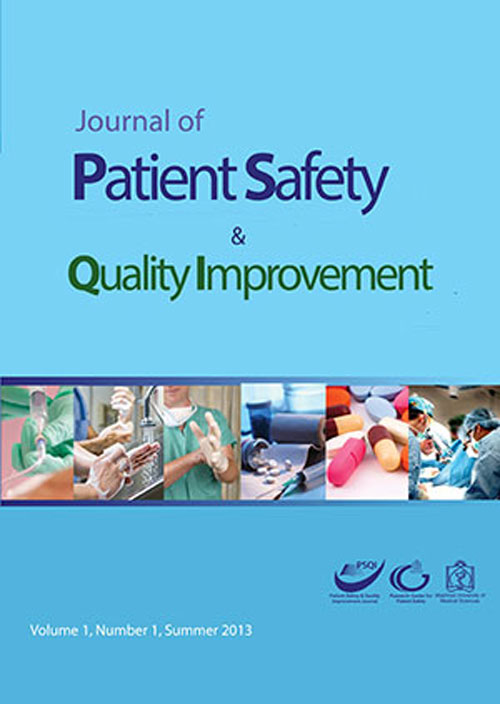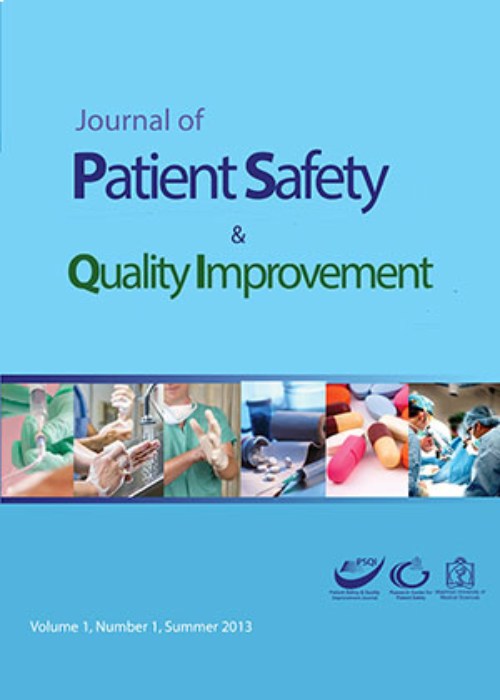فهرست مطالب

Journal Of Patient safety and quality improvement
Volume:9 Issue: 3, Summer 2021
- تاریخ انتشار: 1400/07/10
- تعداد عناوین: 7
-
Pages 133-140Introduction
This study aimed to compare symptoms of anxiety disorders and related transdiagnostic factors in cancer patients and healthy individuals.
Materials and MethodsIn this causal-comparative study, 30 patients with cancer and 30 healthy individuals were selected by the convenience sampling method. The groups were matched in demographic characteristics with each other. The participates completed the Generalized Anxiety Disorder Scale-7 (2006), Severity Measure for Panic Disorder-Adult (2013), Social Phobia Inventory (2000), Cognitive Avoidance Questionnaire (2008), Intolerance of Uncertainty Scale (1994), Metacognition Questionnaire (2004), Acceptance and Action Questionnaire-II (2011), and Cognitive Emotion Regulation Questionnaire (2006). Data were analyzed by SPSS software (version 24), using a one-way analysis of variance. The significance level was 0.05.
ResultsThe results showed that there was a significant difference between the two groups in symptoms of generalized anxiety (GAD) and panic disorders (PD) (P<0.05). However, no significant difference was observed in symptoms of a social anxiety disorder (P>0.05). In addition, there was a significant difference between the two groups in all transdiagnostic factors (P<0.05).
ConclusionIndividuals with cancer were reported more symptoms of GAD and PD and related transdiagnostic factors than those in the control group.
Keywords: Anxiety Disorder, Cancer, metacognition, Transdiagnostic Factors, Uncertainty -
Pages 141-153Introduction
The goal of this research was to determine the recording and implementation of patient safety during a pandemic.
Materials and MethodsThis study was conducted through in 2 phases. In the first phase, the design used is pre and post-design. The researchers analyzed patient safety reports from each treatment room. The data collected retrospectively were patient safety data in the patient safety recording 2019 and data in the 2020 report. The second part consisted of conducting structured interviews through focus group discussions held in two sessions, with five respondents in each session.
ResultsA total of 33 patient care units were included in this study. There were differences in the recording and reporting of patient safety before the pandemic and during the pandemic (P=0.001), there were differences in the implementation of patient identification (P= 0.026), there was a difference in effective communication (P= 0.040), while drug alertness was not significantly different (P= 0.970); there was a difference in the accuracy of surgical procedures (P= 0.016), there was a difference in infection prevention (P= 0.011), and prevention of falling risk (P= 0.001).
ConclusionThere was a decrease in the number of recordings and reporting on patient safety because officers serving patients are more focused on the condition of patients with Covid-19. Nurses are faced with a new disease that raises concerns about transmission and the use of complete PPE so that voices are not heard. Recommendations for using research results as learning materials in policymaking.
Keywords: Patient safety, Pandemic, Recording -
Pages 155-162Introduction
Administering medication is a vital aspect of patients’ treatment and nurses play an essential role in it, with the responsibility of safety during the procedure. Nurse administrators are showing concern about patient safety, and one of the first steps to reduce medication administration errors is assessing the factors contributing to those errors.
Materials and MethodsThe study was descriptive and adopted cross-sectional design. The Medication Administration Safety Assessment Tool and instrument for assessing barriers to medication administration safety were used for data collection. Proportionate and systematic samplings were used in selecting the respondents. Data collected were analysed using SPSS version 26. Chi-square and ANOVA statistical tools were used for inferential analysis.
ResultsThe majority (40.7%) of the respondents were having Good medication administration safety practices, but 19.1% had poor medication administration safety practices. Majority (41.6%) of the respondents had very low perceived barriers to medication administration safety. There was no significant association between hospital working experience and medication administration safety practices, P>0.05. The professional qualification of the respondents was associated with perceived barriers to medication administration safety, P<0.05.
ConclusionThe medication administration safety practices range from good to very good practices, and there was a considerable number of respondents with poor practices. Moreover, a significant number of respondents perceived the barriers to medication administration safety practices as moderate, high or very high. These call for the need for frequent knowledge update through conferences, workshops and educational forums among nurses. Frequent investigation and mitigation of factors aggravating hospitals’ medication administration errors should be given more emphasis.
Keywords: Medication Administration, Nurses, Perceived barriers, Safety -
Pages 163-175Introduction
In emergency departments (ED), human reliability assessment is essential for improving the quality of treatment and preventing medical accidents. A medical accident is expressed as an injury to a patient caused by the negligence of a doctor or nurse who is providing medical care. This study aimed to assess the human reliability in the cardiopulmonary resuscitation (CPR) process and recommend some comments to minimize human errors and improve patient safety.
Materials and MethodsThe main factors in the CPR process (such as rate and depth of chest compression and rate of ventilation) are identified based on the American heart association (AHA) roles. Data were recorded during three months in the evening shifts in the ED and CPR room of Imam Reza Hospital in Mashhad, Iran. In total, 42 samples were collected, and a modified hybrid approach according to the fault tree analysis and Markov method was proposed for the analysis of CPR team (including emergency medicine, medical interns, and nurses) reliability in the resuscitation process. Finally, the important basic events (errors) were selected using the Boruta algorithm by R software.
ResultsAn FTA-Markov-based hybrid method is considered to compute the human reliability in the CPR process. The obtained results from human reliability analysis using the sensitivity analysis via Boruta algorithm and the proposed hybrid method show that an interrupt between chest compression process for rhythm control, the cycle of CPR, the depth of chest compression, and the discussion about reversible causes are the most effective factors in the human reliability of CPR process.
ConclusionThe human reliability of the CPR process in the ED has been assessed using a hybrid method based on the FTA and Markov method for the first time. To improve the quality of treatment and prevent medical accidents during the CPR process, the main factors in the process are identified, and then, the proposed hybrid method is used to calculate human reliability.
Keywords: Fault Tree Analysis (FTA), Markov model, Medical errors, Patient Safety, Quality Improvement -
Pages 177-182IntroductionPoisoning with acute opioids and stimulant is the most common causes of emergency visits, and its early detection and treatment is of utmost importance. The present study aimed to evaluate the frequency of opioid and stimulant use in poisoned cases.Materials and MethodsThis cross-sectional descriptive study was conducted on 255 cases with acute opioids and stimulant poisoning.ResultsOut of all patients, 7(2.7%) patients died due to severe complications. Moreover, 72.2% of patients were male, and the majority of cases (86.87%) were urban residents. The leading cause of poisoning was suicide (65.1%), and 34.9% of patients had accidental poisoning. The mean age of patients was 36.26 years. Tramadol, methadone, and opium with 29.4%, 23.9%, and 23.5% were the most used opioids for poisoning, respectively.ConclusionAs evidenced by the obtained results, tramadol poisoning is the most common poisoning in patients referring to hospital emergence. Nevertheless, tramadol use and availability need to be prevented and controlled; moreover, the awareness of health system providers should be raised about the care of these patients.Keywords: Acute poisoning, Frequency, Opium, Stimulants, Tramadol
-
Pages 183-187IntroductionDrug package inserts are officially approved documents provided along with the drugs by the drug marketing company. They act as an important source of information about the drug for both patients and physicians, which helps in proper administration and improving the safe use of medications. The pharmacological and clinical information presented in them for its consistency and completeness were analyzed in this study.Materials and MethodsThe drug package inserts were collected and analyzed for the pharmacological and clinical information, based on the headings under Section 6.2 & Section 6.3 mentioned in Schedule D of Drugs and Cosmetics Act and Rules, 1945. The drug package inserts that were analyzed in this study included different drug formulations and drugs belonging to different systems.ResultsThis study shows that the generic name, the brand name of the drug, its active ingredient, therapeutic uses, dosage form, and manufacturer details are present in all the package inserts (100%). But details about safety and precautions are given only in about 90%. Information about pharmacokinetics, pharmacodynamics, pharmaceutical particulars, and the antidote for drug overdose are missing in many package inserts.ConclusionFrom our study, we conclude that a majority of the package inserts provide adequate details regarding key information. However, we recommend mentioning the approximate cost of the drug, references for the information provided in it, along with the Toll-free number of the Pharmacovigilance Programme of India (PVPI) for reporting adverse drug effects.Keywords: Drug package inserts, Drug information, Schedule D, Pharmacovigilance
-
Pages 189-197IntroductionIn recent years, the quality of life has become an important final health status indicator. Thus, increasing the quality of life in the growing population of the elderly is one of the most important goals in healthcare. The purpose of this study was to determine the quality of life of the elderly staying in nursing homes.Materials and MethodsThe research was carried out at the Gürçeşme Zübeyde Hanım Nursing Home, date between 1 July-30 August 2011, in İzmir. 103 elderly individuals, who met the inclusion criteria, constituted the research sample. Researcher collected data in face to face with the elderly participants.Results52% of the participants are in 75-84 age group. 58% of the elderly were female; 56,3% were widowed; 61.2% were not literate; 39% have been staying in a nursing home because of no one to look after them; 41.7% had lived in a nursing home longer than seven years. 68.9% had at least one chronic disease, 58.3% of the elderly expressed their quality of life as good. WHOQOL-OLD total score was between 52-86 points (mean 70). The lowest scale mean score was sensory abilities and death and dying, sub-dimension group.ConclusionThe quality of life in elderly people was affected directly by variables such as age, educational level, marital status, social capacity, chronic illnesses, income status, and length of staying in a nursing home. We suggest that improving the social activities and facilities of the institution in line with the results obtained.Keywords: Elderly, OLD, Quality-of-life, WHOQOL


